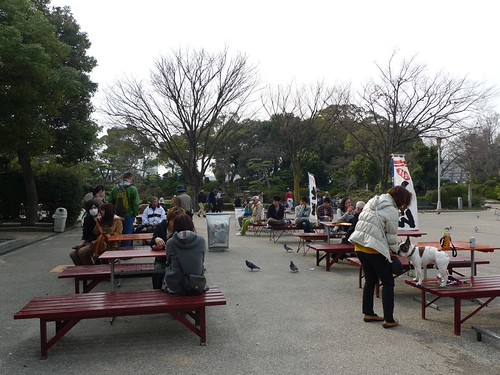Have you noticed when you travel that there’s always the rush to see so many places in such a short time, so that the total effect for the tourist is to grow weary and tired? When we visited the famous landmark Osaka Castle, we decided that there’s going to be none of the “race to have the most number of photos” thing and just enjoy our day at the park, before taking the next train to Kyoto that is!
First of all, I am enchanted with the idea of a castle and how there was so much to love about that park. Being a cool (not cold) day in March, I easily warmed to the vast expanse and what was left of the fall foliage which looked beautiful, even when bald.
Older Japanese people strolled the walkways of the park, almost in a single file. I gained a new understanding of the Japanese on this trip, at the same time trying to empathize with what’s happening up north. What’s in store for the future? Heaven knows, but somehow I can only feel nostalgic about it all.
People sat in the benches eating, talking, laughing and tending to their dogs. I just sat there admiring the surroundings while pining for a hot cup of coffee. The area around Osaka Castle was a public park, but everything was kept clean, even the toilets.
People were having fun with the cut-out photobooths….
A girl was having fun playing her transparent ball. We wanted a similar ball for our daughter, but it wasn’t available in any of the souvenir shops inside
I also liked these stone formations in the park which beautifully contrasted with the trees and the buildings in the background. It was very serene, and doesn’t give an indication of the overall turmoil that Japan is experiencing right now.
A view of Osaka Castle.
Its history dates back to 1496 when “a high-ranking monk of the Joudoshinshu sect had a monastic residence built near the site of the present-day Castle. This eventually grew into a large temple known as Osaka Honganji. The temple boasted great power and influence until 1580 when it yielded to Nobunaga Oda during his campaign of national unification and it burned to the ground.
After the death of Nobunaga Oda, Hideyoshi Hashiba (Toyotomi) took control of political affairs and began construction of a castle on the site of Hinganji Temple. He built a castle befitting the permanent residence of the ruler of Japan. However, after his death, political control moved to the Tokugawas and the castle fell during the Summer War in Osaka in 1615.”
“By command of the second shogun, Hidetada, reconstruction of Osaka Castle began in 1620 which took 10 years to complete. The castle played a major role as the base for the shogunate’s control of Western Japan. Many buildings were later destroyed by blaze during the turbulent transition to Imperial Restoration.
After the Meiji Period, the Osaka Castle site was used by the army. During this time, in 1931, public efforts and enthusiasm brought about the reconstruction of the Main Tower, which operates as a museum today. The area around the castle were damaged during the bombing raids of World War II, but were restored and turned into a historic park after the war.”
(From a brochure)







What a lovely and clean place. I commend Japanese for their sense of discipline. I really wish to see Japan someday and get to marvel the kind of castles they have.
Thanks for dropping by Saggi.
Hope Japan recovers soon so travellers like you can enjoy travelling it, in peace!:)
I prefer to travel slowwwww myself. Travel is not about the piktyuran-kodakan but more on enjoying and being familiar with the place
Hi Prime. Yes, I agree. Wish we had more time